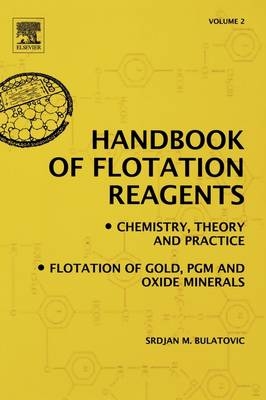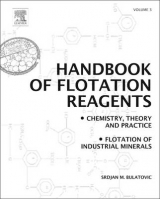
Handbook of Flotation Reagents: Chemistry, Theory and Practice
Volume 2: Flotation of Gold, PGM and Oxide Minerals
Seiten
2010
Elsevier Science Ltd (Verlag)
978-0-444-53082-0 (ISBN)
Elsevier Science Ltd (Verlag)
978-0-444-53082-0 (ISBN)
- Titel erscheint in neuer Auflage
- Artikel merken
Zu diesem Artikel existiert eine Nachauflage
Suitable for researchers and plant metallurgists, this title presents a condensed form of the fundamental knowledge of chemical reagents commonly used in flotation. It provides description of the chemistry used in mineral processing industry. It describes theoretical aspects of the action of flotation reagents.
Handbook of Flotation Reagents: Chemistry, Theory and Practice: Flotation of Gold, PGM and Oxide Minerals, Volume 2 focuses on the theory, practice, and chemistry of flotation of gold, platinum group minerals (PGMs), and the major oxide minerals, along with rare earths. It examines separation methods whose effectiveness is limited when using conventional treatment processes and considers commercial plant practices for most oxide minerals, such as pyrochlore-containing ores, copper cobalt ores, zinc ores, tin ores, and tantalum/niobium ores. It discusses the geology and mineralogy of gold, PGMs, and oxide minerals, as well as reagent and flotation practices in beneficiation. The book also looks at the factors affecting the floatability of gold minerals and describes PGM-dominated deposits such as Morensky-type deposits, hydrothermal deposits, and placer deposits. In addition, case studies of flotation and beneficiation in countries such as Canada, Africa, Russia, Chile, and Saudi Arabia are presented. This book will be useful to researchers, university students, and professors, as well as mineral processors faced with the problem of beneficiation of difficult-to-treat ores.
Handbook of Flotation Reagents: Chemistry, Theory and Practice: Flotation of Gold, PGM and Oxide Minerals, Volume 2 focuses on the theory, practice, and chemistry of flotation of gold, platinum group minerals (PGMs), and the major oxide minerals, along with rare earths. It examines separation methods whose effectiveness is limited when using conventional treatment processes and considers commercial plant practices for most oxide minerals, such as pyrochlore-containing ores, copper cobalt ores, zinc ores, tin ores, and tantalum/niobium ores. It discusses the geology and mineralogy of gold, PGMs, and oxide minerals, as well as reagent and flotation practices in beneficiation. The book also looks at the factors affecting the floatability of gold minerals and describes PGM-dominated deposits such as Morensky-type deposits, hydrothermal deposits, and placer deposits. In addition, case studies of flotation and beneficiation in countries such as Canada, Africa, Russia, Chile, and Saudi Arabia are presented. This book will be useful to researchers, university students, and professors, as well as mineral processors faced with the problem of beneficiation of difficult-to-treat ores.
Chapter 17. Flotation of Gold Ores
Chapter 18. Flotation of Platinum Group Metal Ores
Chapter 19. Flotation of Oxide Copper and Copper Cobalt Ores
Chapter 20. Flotation of Mixed Lead Zinc Sulphide Oxide and Oxide Lead and Zinc Ores
Chapter 21. Flotation of Tin Minerals
Chapter 22. Flotation of Niobium
Chapter 23. Flotation of Tantalum/Niobium Ores
Chapter 24. Flotation of REO Minerals
Chapter 25. Flotation of Titanium Minerals
| Erscheint lt. Verlag | 15.9.2010 |
|---|---|
| Verlagsort | Oxford |
| Sprache | englisch |
| Maße | 165 x 240 mm |
| Gewicht | 580 g |
| Themenwelt | Naturwissenschaften ► Chemie ► Allgemeines / Lexika |
| Naturwissenschaften ► Chemie ► Technische Chemie | |
| Technik ► Umwelttechnik / Biotechnologie | |
| ISBN-10 | 0-444-53082-7 / 0444530827 |
| ISBN-13 | 978-0-444-53082-0 / 9780444530820 |
| Zustand | Neuware |
| Haben Sie eine Frage zum Produkt? |
Mehr entdecken
aus dem Bereich
aus dem Bereich
Eine chemische Warenkunde
Buch | Softcover (2022)
Wiley-VCH (Verlag)
CHF 41,85



